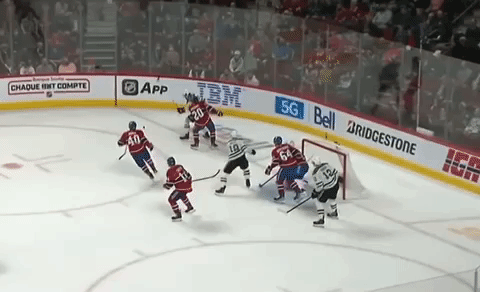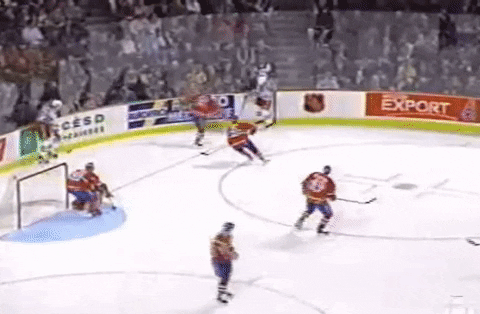Finding Space: Working 'Off The Net'
Finding and creating space by working off the net
Creating space on the ice is vital. But space can be really difficult to find. One underutilized way of creating time and space is to use the goal itself to your advantage.
Running Your Check in to the Net
In the clip below, we see the Washington Capitals defending in a man-on-man defense system. Boston Bruin’s forward David Pastrnak knows that his check/opponent John Carlson will chase him and skates so tightly to the net that Carlson skates into and trips over his own net. Pastrnak find himself free and circles into the slot for a high-danger scoring opportunity that found the back of the net.
Below, Toronto Maple Leafs forward William Nylander gives us an excellent example of shaking his check. At first, he uses the net that forces the his defender into cutting behind his own goalie. He then skates his check into traffic where he can finally shake him. Extremely effective.
This tactic isn’t just for the skills players. Here, Nashville Predators forward Yakov Trenin rolls off the front post and moves to the backside. His check was unable to easily follow and got caught in the net-front traffic.
Between Coverages
Behind the net can be a difficult spot for defenders. It’s an area that is often between coverages, particularly against zone coverage defenses.
Below, Maple Leafs forward Mitch Marner works off the front side post and slides his movement behind the net. One defender chases him behind the net while his original check stays in front within the goalie’s crease. With two defenders electing to worry about Marner, John Tavares is left open and able to score an easy goal.
Then-Calgary Flames forward Johnny Gaudreau, in a play that rhymes with Marner’s, slides his movement to catch the puck behind the net. The defender has to go around the net and vacates his net-front positioning.
Blind Spot / Getting Lost
Minnesota Wild forward Kirill Kaprizov uses the net twice in the below clip to generate offense. First, he is a flash screen in front, then moves from the back post and passes out front. Second, once he passes the puck, Kaprizov relocated to the back post and was left wide open. He moved between coverages multiple times and made life miserable for the opposing defenders.
Then-Dallas Stars forward Michael Raffl skates his check into the back of the net and force his check to pass him off to a teammate. Raffl’s teammate, Radek Faksa, meanwhile worked off the back post away from the puck and got completely lost. He was able to lose his coverage and became free near the net for the eventual goal.
Whether tempting the defender to chase behind to leave the net front, challenging their route to follow, or finding a soft spot in the defense. The goal scorer ends up attracting both defensemen before being lost behind them for an easy goal.
Watch again… right defensemen Jeff Petry (#26) starts as the defender. Then it switches to Kris Letang (#58). And lastly switches back to Petry. Very difficult given the Penguins (and many modern day) defensive system.
Gretzky’s Office
Using the idea that the behind-the-net play is between coverages, Wayne Gretzky was well ahead of his time with his behind-the-net spot usage. This was born from the fact that he was slight stature compared to many opponents. It didn’t hurt that the goalies were unable to track the play as well with the puck outside of their vision, and it put defensemen in a difficult position.
I love this behind the net camera angle of Gretzky. If you look incredibly close you can see the eventual goal scorer put up his finger as if to say “wait one second” as he circles away before coming back.
Once more, Gaudreau sets himself up in “Gretzky’s office.” This is an area that is difficult for most teams as it’s a gray area in their defensive coverage.
Penguins forward Teddy Blueger challenges the defender by using the net as a screen. Does the defender chase behind or stay in front? Regardless of what the defender decides, Blueger has the solution.
The defender has stick and body oriented to defend the short side, Teddy goes out the far side for a nice assist:
Activity/Drill Recommended For Hockey Coaches
One popular small-area game is called “Gretzky’s Office”. One player on each team is designated as “Gretzky” and stays behind the goal for the duration of the set. Typically, it’s a 2v2 (plus Gretzky’s) game, and you can play cross-ice (if you don’t care about ice geography) or have an “all-time Gretzky” and just play behind the net as normally positioned. This allows for Gretzky and his teammates to practice a down-low 3v2, and can put defenses in compromised positions.
Further Reading













